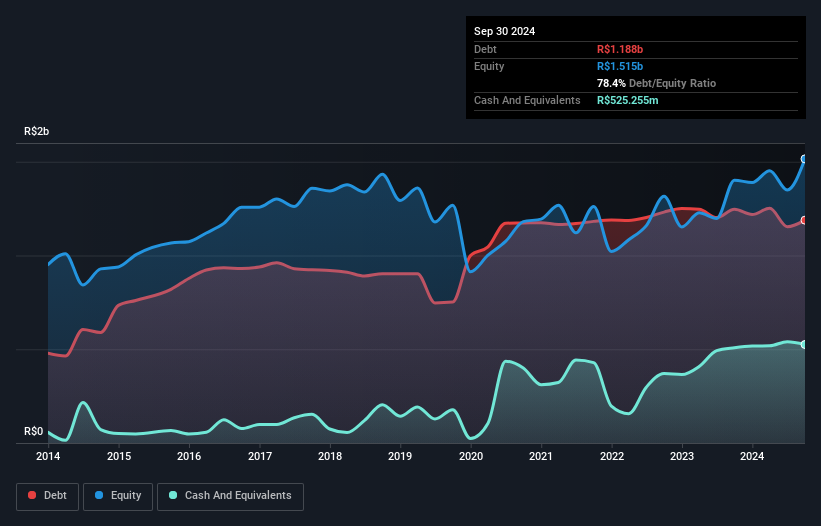- Brazil
- /
- Gas Utilities
- /
- BOVESPA:CEGR3
Here's Why Companhia Distribuidora de Gás do Rio de Janeiro - CEG (BVMF:CEGR3) Can Manage Its Debt Responsibly

Some say volatility, rather than debt, is the best way to think about risk as an investor, but Warren Buffett famously said that 'Volatility is far from synonymous with risk.' When we think about how risky a company is, we always like to look at its use of debt, since debt overload can lead to ruin. We note that Companhia Distribuidora de Gás do Rio de Janeiro - CEG (BVMF:CEGR3) does have debt on its balance sheet. But is this debt a concern to shareholders?
What Risk Does Debt Bring?
Debt is a tool to help businesses grow, but if a business is incapable of paying off its lenders, then it exists at their mercy. If things get really bad, the lenders can take control of the business. However, a more frequent (but still costly) occurrence is where a company must issue shares at bargain-basement prices, permanently diluting shareholders, just to shore up its balance sheet. Of course, debt can be an important tool in businesses, particularly capital heavy businesses. When we examine debt levels, we first consider both cash and debt levels, together.
View our latest analysis for Companhia Distribuidora de Gás do Rio de Janeiro - CEG
What Is Companhia Distribuidora de Gás do Rio de Janeiro - CEG's Net Debt?
You can click the graphic below for the historical numbers, but it shows that Companhia Distribuidora de Gás do Rio de Janeiro - CEG had R$1.19b of debt in September 2024, down from R$1.25b, one year before. However, because it has a cash reserve of R$525.3m, its net debt is less, at about R$663.2m.

How Strong Is Companhia Distribuidora de Gás do Rio de Janeiro - CEG's Balance Sheet?
The latest balance sheet data shows that Companhia Distribuidora de Gás do Rio de Janeiro - CEG had liabilities of R$1.35b due within a year, and liabilities of R$1.87b falling due after that. Offsetting these obligations, it had cash of R$525.3m as well as receivables valued at R$756.3m due within 12 months. So its liabilities total R$1.94b more than the combination of its cash and short-term receivables.
Of course, Companhia Distribuidora de Gás do Rio de Janeiro - CEG has a market capitalization of R$17.3b, so these liabilities are probably manageable. But there are sufficient liabilities that we would certainly recommend shareholders continue to monitor the balance sheet, going forward.
In order to size up a company's debt relative to its earnings, we calculate its net debt divided by its earnings before interest, tax, depreciation, and amortization (EBITDA) and its earnings before interest and tax (EBIT) divided by its interest expense (its interest cover). The advantage of this approach is that we take into account both the absolute quantum of debt (with net debt to EBITDA) and the actual interest expenses associated with that debt (with its interest cover ratio).
While Companhia Distribuidora de Gás do Rio de Janeiro - CEG's low debt to EBITDA ratio of 0.62 suggests only modest use of debt, the fact that EBIT only covered the interest expense by 6.4 times last year does give us pause. So we'd recommend keeping a close eye on the impact financing costs are having on the business. On the other hand, Companhia Distribuidora de Gás do Rio de Janeiro - CEG saw its EBIT drop by 8.1% in the last twelve months. That sort of decline, if sustained, will obviously make debt harder to handle. The balance sheet is clearly the area to focus on when you are analysing debt. But you can't view debt in total isolation; since Companhia Distribuidora de Gás do Rio de Janeiro - CEG will need earnings to service that debt. So when considering debt, it's definitely worth looking at the earnings trend. Click here for an interactive snapshot.
Finally, a business needs free cash flow to pay off debt; accounting profits just don't cut it. So the logical step is to look at the proportion of that EBIT that is matched by actual free cash flow. In the last three years, Companhia Distribuidora de Gás do Rio de Janeiro - CEG's free cash flow amounted to 44% of its EBIT, less than we'd expect. That's not great, when it comes to paying down debt.
Our View
On our analysis Companhia Distribuidora de Gás do Rio de Janeiro - CEG's net debt to EBITDA should signal that it won't have too much trouble with its debt. However, our other observations weren't so heartening. For example, its EBIT growth rate makes us a little nervous about its debt. It's also worth noting that Companhia Distribuidora de Gás do Rio de Janeiro - CEG is in the Gas Utilities industry, which is often considered to be quite defensive. When we consider all the elements mentioned above, it seems to us that Companhia Distribuidora de Gás do Rio de Janeiro - CEG is managing its debt quite well. Having said that, the load is sufficiently heavy that we would recommend any shareholders keep a close eye on it. When analysing debt levels, the balance sheet is the obvious place to start. But ultimately, every company can contain risks that exist outside of the balance sheet. These risks can be hard to spot. Every company has them, and we've spotted 2 warning signs for Companhia Distribuidora de Gás do Rio de Janeiro - CEG (of which 1 is concerning!) you should know about.
If you're interested in investing in businesses that can grow profits without the burden of debt, then check out this free list of growing businesses that have net cash on the balance sheet.
New: AI Stock Screener & Alerts
Our new AI Stock Screener scans the market every day to uncover opportunities.
• Dividend Powerhouses (3%+ Yield)
• Undervalued Small Caps with Insider Buying
• High growth Tech and AI Companies
Or build your own from over 50 metrics.
Have feedback on this article? Concerned about the content? Get in touch with us directly. Alternatively, email editorial-team (at) simplywallst.com.
This article by Simply Wall St is general in nature. We provide commentary based on historical data and analyst forecasts only using an unbiased methodology and our articles are not intended to be financial advice. It does not constitute a recommendation to buy or sell any stock, and does not take account of your objectives, or your financial situation. We aim to bring you long-term focused analysis driven by fundamental data. Note that our analysis may not factor in the latest price-sensitive company announcements or qualitative material. Simply Wall St has no position in any stocks mentioned.
About BOVESPA:CEGR3
Companhia Distribuidora de Gás do Rio de Janeiro - CEG
Distributes of natural gas in Brazil.
Proven track record with adequate balance sheet.
Market Insights
Community Narratives



